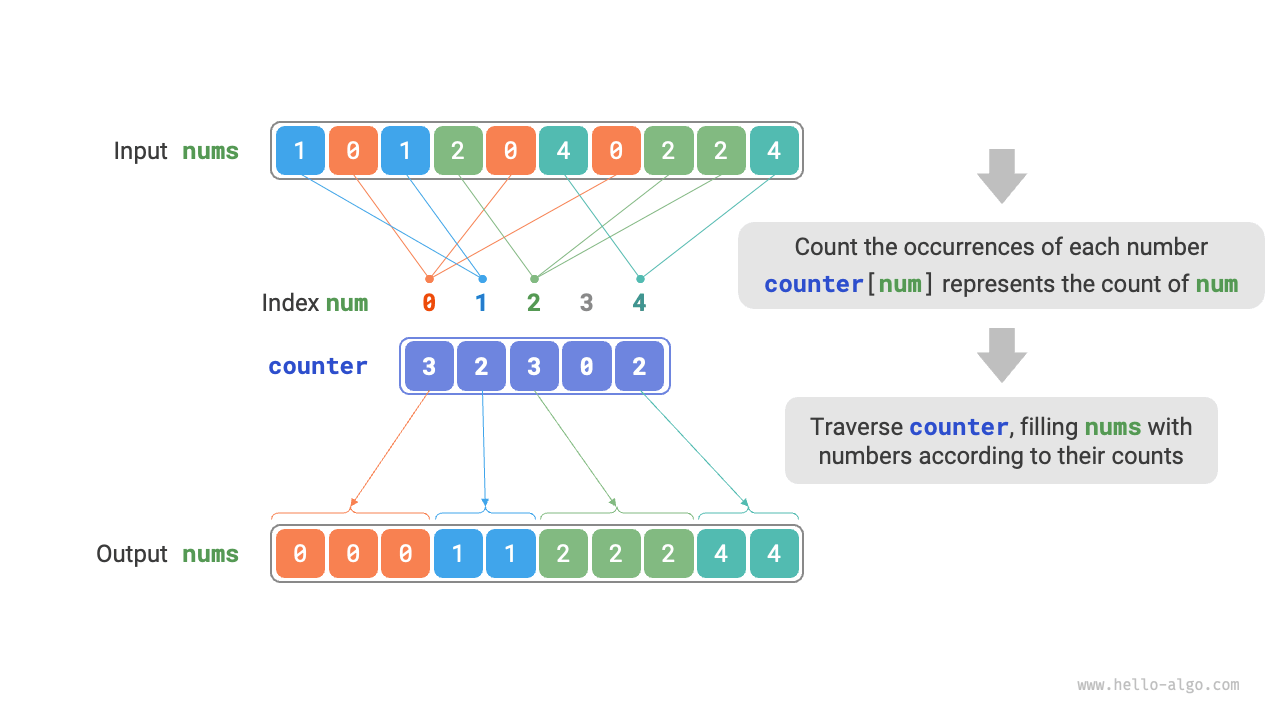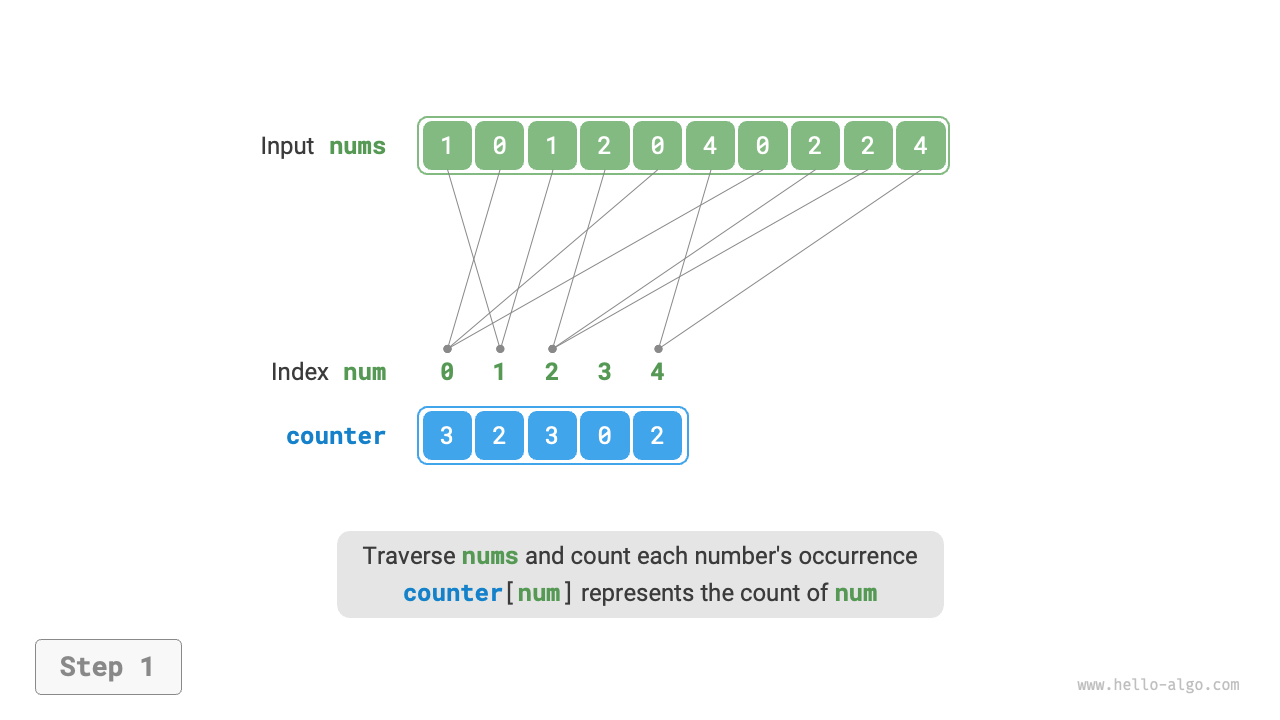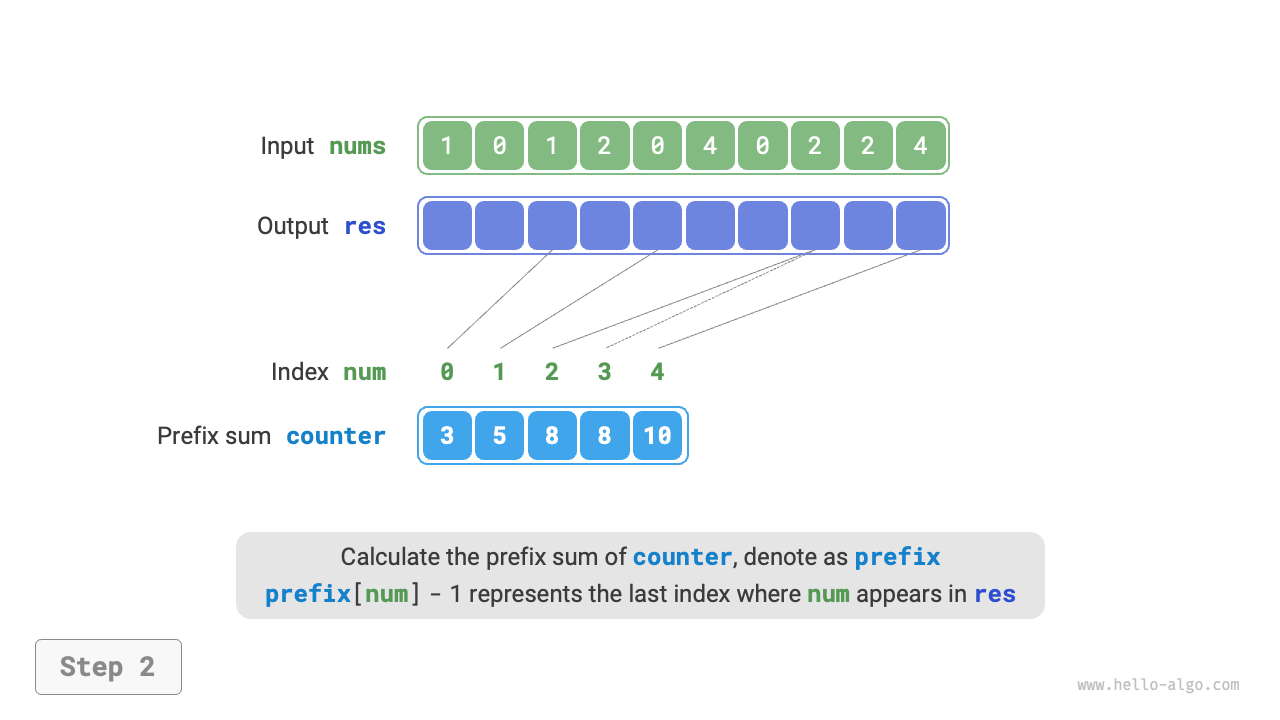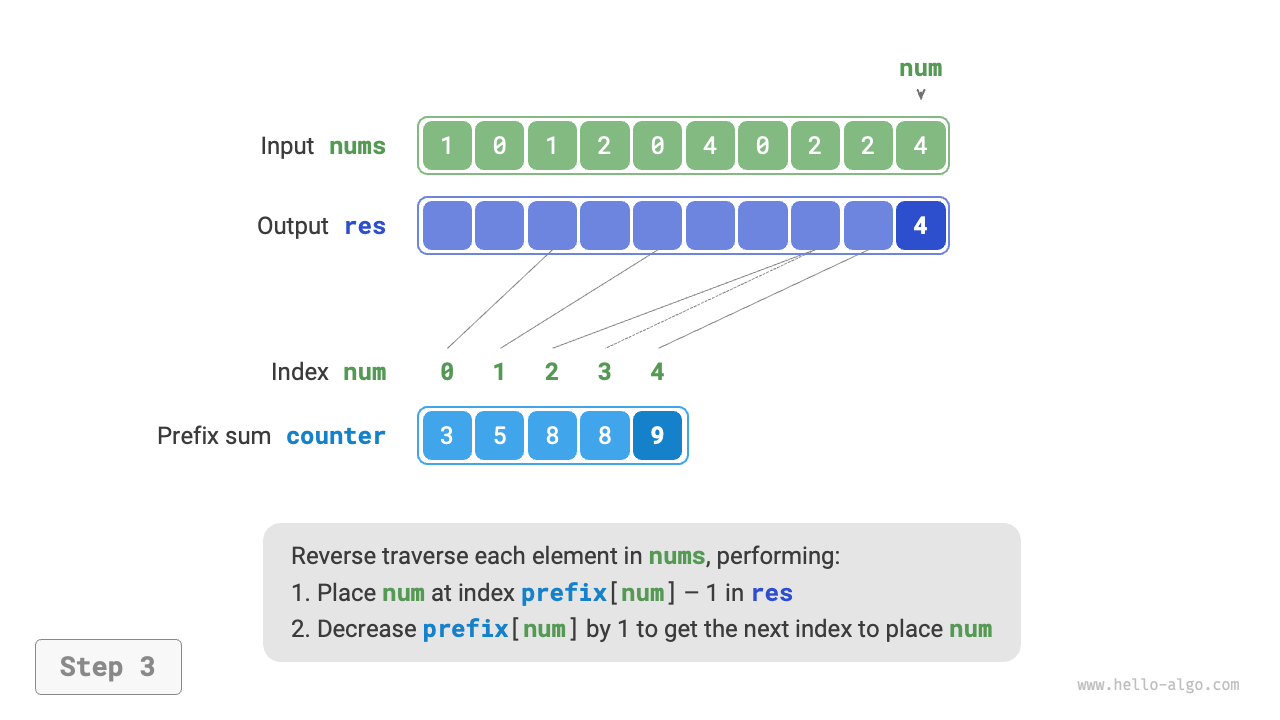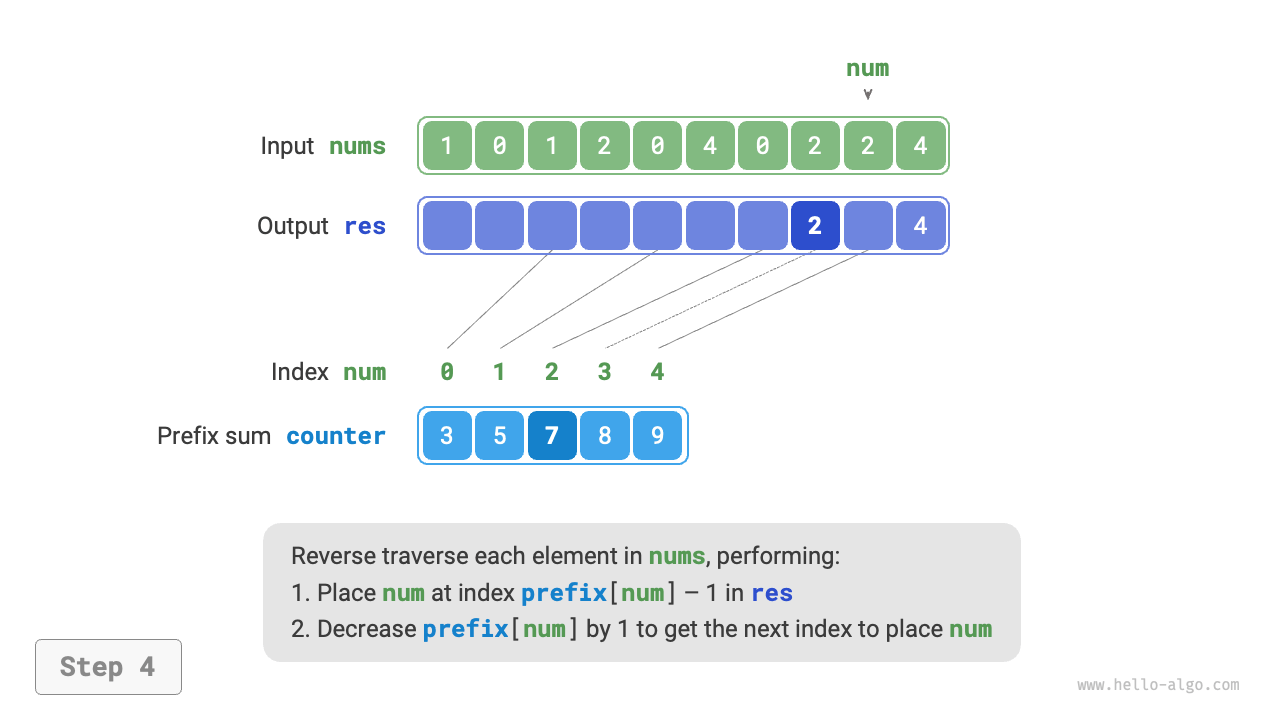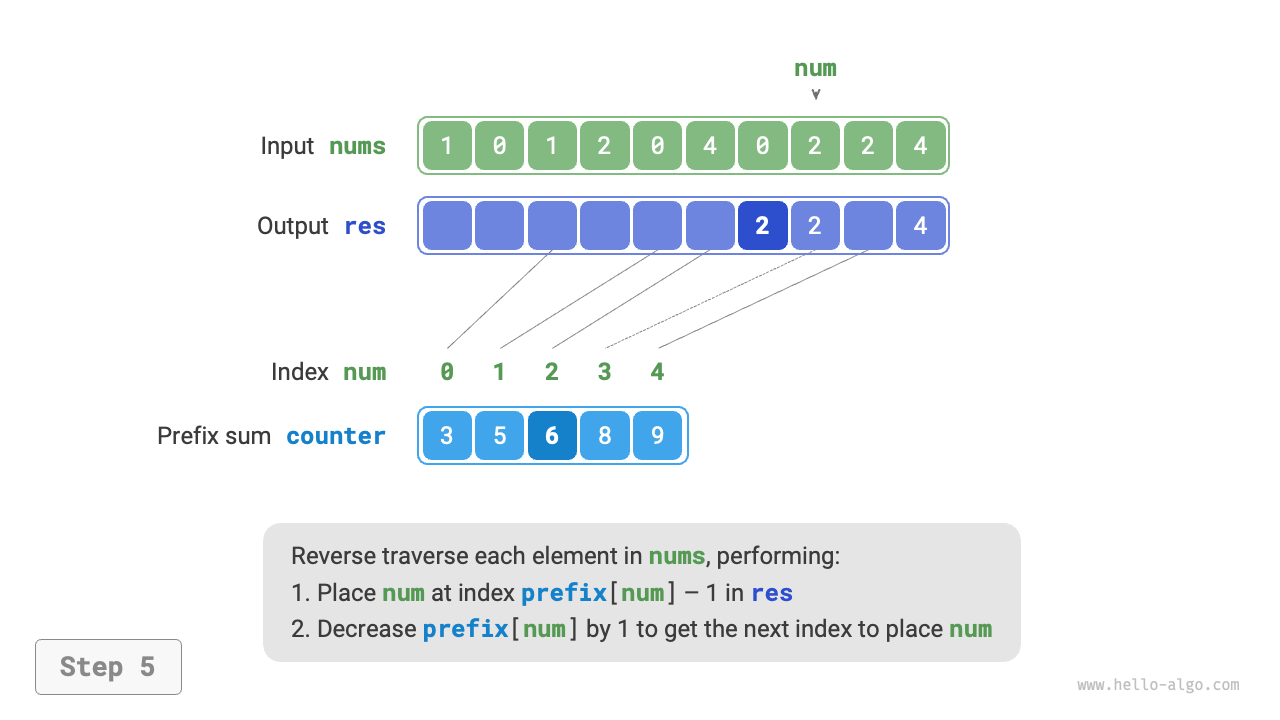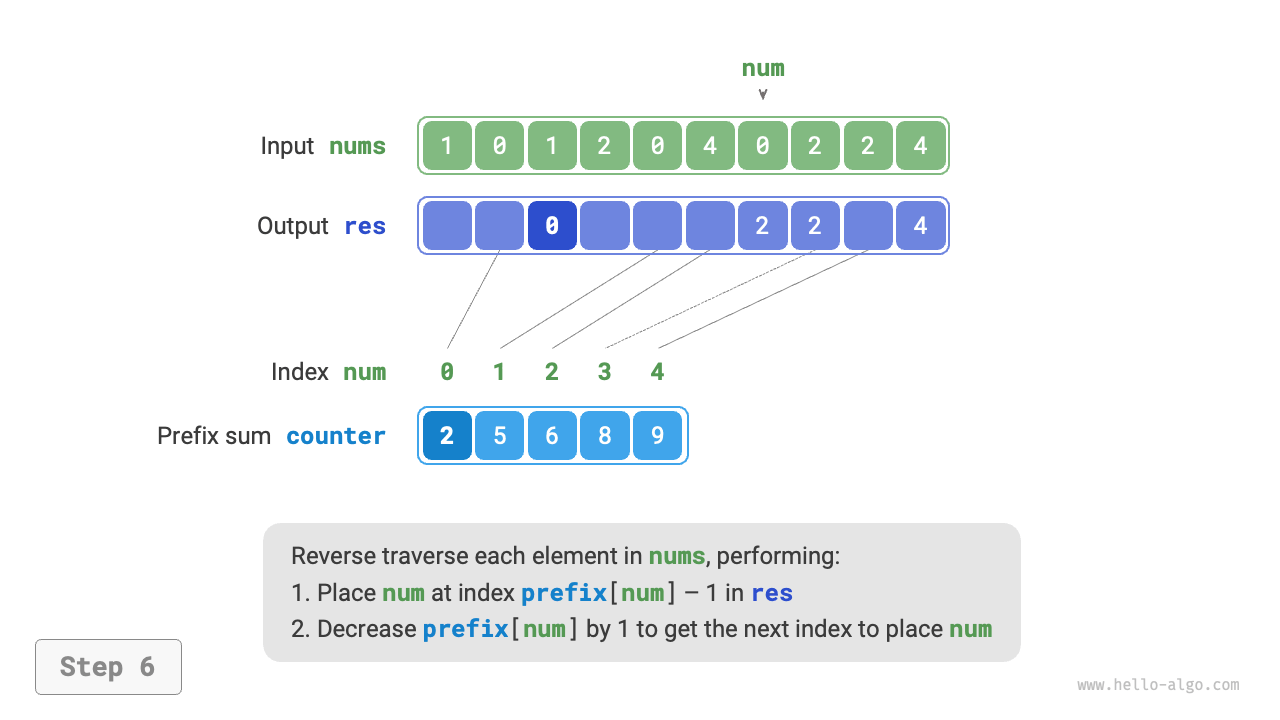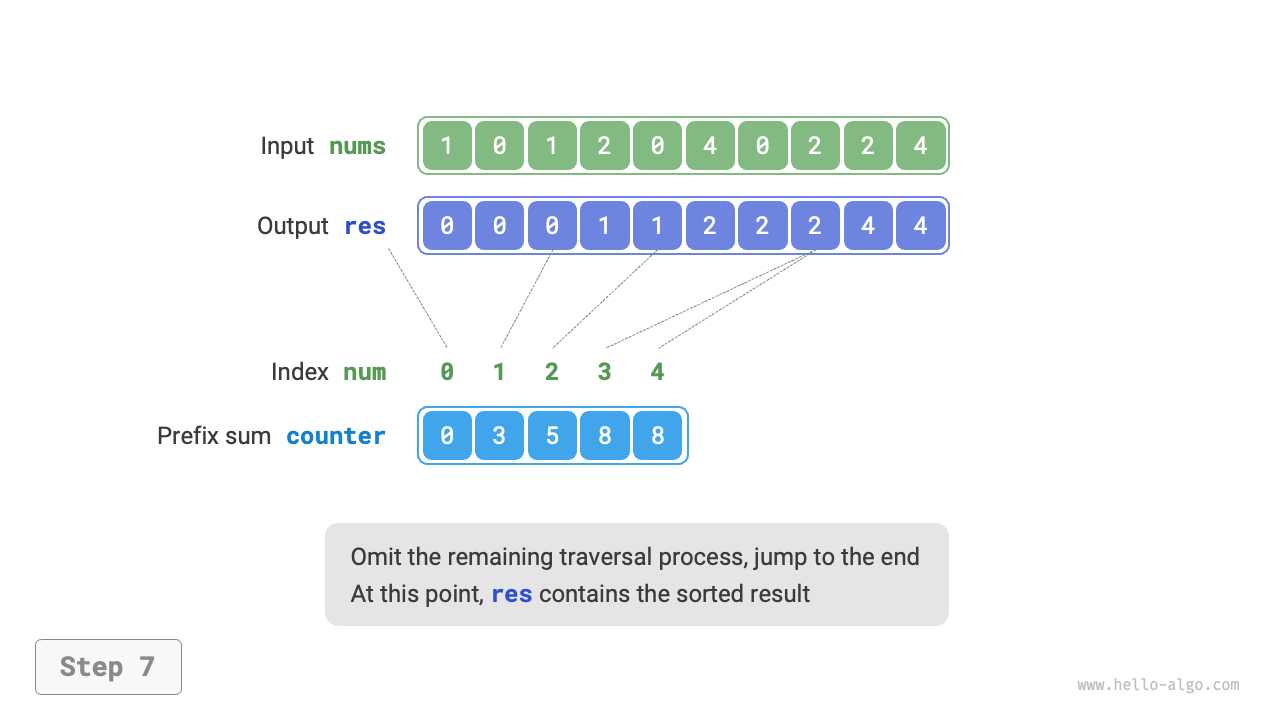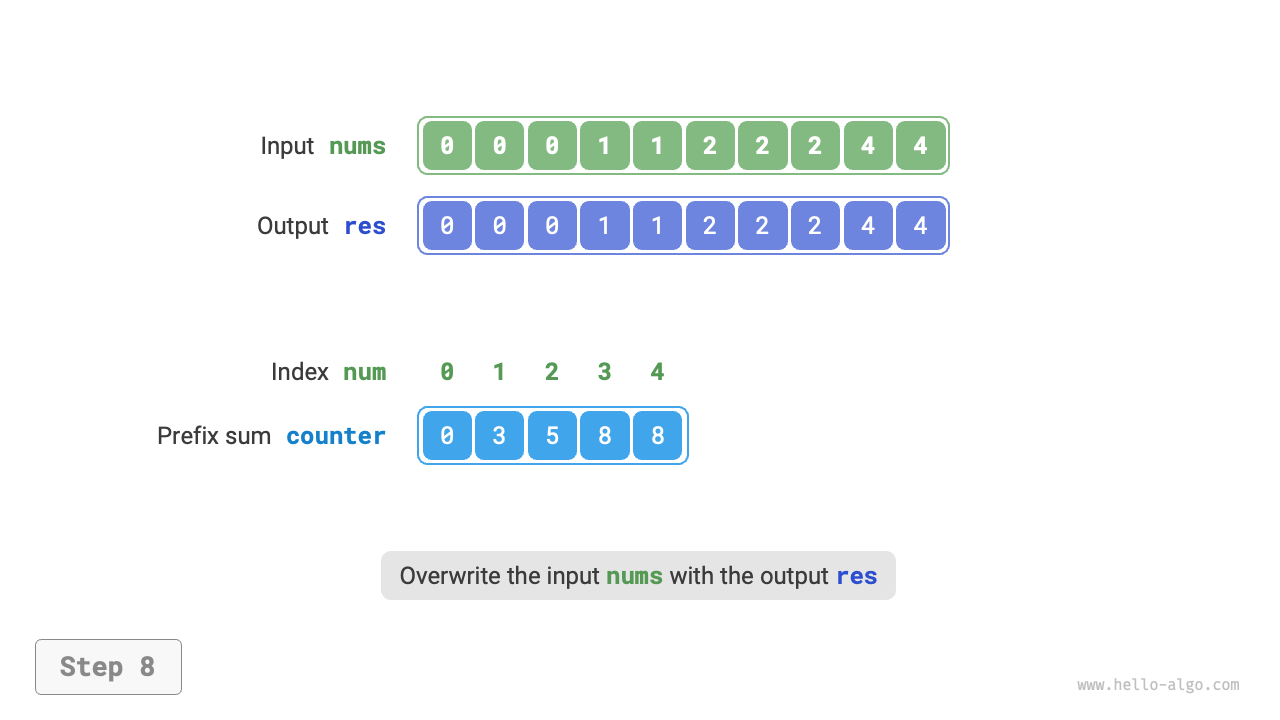11.9 Counting sort¶
Counting sort achieves sorting by counting the number of elements, usually applied to integer arrays.
11.9.1 Simple implementation¶
Let's start with a simple example. Given an array nums of length \(n\), where all elements are "non-negative integers", the overall process of counting sort is shown in Figure 11-16.
- Traverse the array to find the maximum number, denoted as \(m\), then create an auxiliary array
counterof length \(m + 1\). - Use
counterto count the occurrence of each number innums, wherecounter[num]corresponds to the occurrence of the numbernum. The counting method is simple, just traversenums(suppose the current number isnum), and increasecounter[num]by \(1\) each round. - Since the indices of
counterare naturally ordered, all numbers are essentially sorted already. Next, we traversecounter, and fill innumsin ascending order of occurrence.
Figure 11-16 Counting sort process
The code is shown below:
def counting_sort_naive(nums: list[int]):
"""Counting sort"""
# Simple implementation, cannot be used for sorting objects
# 1. Count the maximum element m in the array
m = 0
for num in nums:
m = max(m, num)
# 2. Count the occurrence of each digit
# counter[num] represents the occurrence of num
counter = [0] * (m + 1)
for num in nums:
counter[num] += 1
# 3. Traverse counter, filling each element back into the original array nums
i = 0
for num in range(m + 1):
for _ in range(counter[num]):
nums[i] = num
i += 1
/* Counting sort */
// Simple implementation, cannot be used for sorting objects
void countingSortNaive(vector<int> &nums) {
// 1. Count the maximum element m in the array
int m = 0;
for (int num : nums) {
m = max(m, num);
}
// 2. Count the occurrence of each digit
// counter[num] represents the occurrence of num
vector<int> counter(m + 1, 0);
for (int num : nums) {
counter[num]++;
}
// 3. Traverse counter, filling each element back into the original array nums
int i = 0;
for (int num = 0; num < m + 1; num++) {
for (int j = 0; j < counter[num]; j++, i++) {
nums[i] = num;
}
}
}
/* Counting sort */
// Simple implementation, cannot be used for sorting objects
void countingSortNaive(int[] nums) {
// 1. Count the maximum element m in the array
int m = 0;
for (int num : nums) {
m = Math.max(m, num);
}
// 2. Count the occurrence of each digit
// counter[num] represents the occurrence of num
int[] counter = new int[m + 1];
for (int num : nums) {
counter[num]++;
}
// 3. Traverse counter, filling each element back into the original array nums
int i = 0;
for (int num = 0; num < m + 1; num++) {
for (int j = 0; j < counter[num]; j++, i++) {
nums[i] = num;
}
}
}
Connection between counting sort and bucket sort
From the perspective of bucket sort, we can consider each index of the counting array counter in counting sort as a bucket, and the process of counting as distributing elements into the corresponding buckets. Essentially, counting sort is a special case of bucket sort for integer data.
11.9.2 Complete implementation¶
Observant readers might notice, if the input data is an object, the above step 3. is invalid. Suppose the input data is a product object, we want to sort the products by the price (a class member variable), but the above algorithm can only give the sorted price as the result.
So how can we get the sorting result for the original data? First, we calculate the "prefix sum" of counter. As the name suggests, the prefix sum at index i, prefix[i], equals the sum of the first i elements of the array:
The prefix sum has a clear meaning, prefix[num] - 1 represents the index of the last occurrence of element num in the result array res. This information is crucial, as it tells us where each element should appear in the result array. Next, we traverse each element num of the original array nums in reverse order, performing the following two steps in each iteration.
- Fill
numinto the arrayresat the indexprefix[num] - 1. - Decrease the prefix sum
prefix[num]by \(1\) to obtain the next index to placenum.
After the traversal, the array res contains the sorted result, and finally, res replaces the original array nums. The complete counting sort process is shown in Figure 11-17.
Figure 11-17 Counting sort process
The implementation code of counting sort is shown below:
def counting_sort(nums: list[int]):
"""Counting sort"""
# Complete implementation, can sort objects and is a stable sort
# 1. Count the maximum element m in the array
m = max(nums)
# 2. Count the occurrence of each digit
# counter[num] represents the occurrence of num
counter = [0] * (m + 1)
for num in nums:
counter[num] += 1
# 3. Calculate the prefix sum of counter, converting "occurrence count" to "tail index"
# counter[num]-1 is the last index where num appears in res
for i in range(m):
counter[i + 1] += counter[i]
# 4. Traverse nums in reverse order, placing each element into the result array res
# Initialize the array res to record results
n = len(nums)
res = [0] * n
for i in range(n - 1, -1, -1):
num = nums[i]
res[counter[num] - 1] = num # Place num at the corresponding index
counter[num] -= 1 # Decrement the prefix sum by 1, getting the next index to place num
# Use result array res to overwrite the original array nums
for i in range(n):
nums[i] = res[i]
/* Counting sort */
// Complete implementation, can sort objects and is a stable sort
void countingSort(vector<int> &nums) {
// 1. Count the maximum element m in the array
int m = 0;
for (int num : nums) {
m = max(m, num);
}
// 2. Count the occurrence of each digit
// counter[num] represents the occurrence of num
vector<int> counter(m + 1, 0);
for (int num : nums) {
counter[num]++;
}
// 3. Calculate the prefix sum of counter, converting "occurrence count" to "tail index"
// counter[num]-1 is the last index where num appears in res
for (int i = 0; i < m; i++) {
counter[i + 1] += counter[i];
}
// 4. Traverse nums in reverse order, placing each element into the result array res
// Initialize the array res to record results
int n = nums.size();
vector<int> res(n);
for (int i = n - 1; i >= 0; i--) {
int num = nums[i];
res[counter[num] - 1] = num; // Place num at the corresponding index
counter[num]--; // Decrement the prefix sum by 1, getting the next index to place num
}
// Use result array res to overwrite the original array nums
nums = res;
}
/* Counting sort */
// Complete implementation, can sort objects and is a stable sort
void countingSort(int[] nums) {
// 1. Count the maximum element m in the array
int m = 0;
for (int num : nums) {
m = Math.max(m, num);
}
// 2. Count the occurrence of each digit
// counter[num] represents the occurrence of num
int[] counter = new int[m + 1];
for (int num : nums) {
counter[num]++;
}
// 3. Calculate the prefix sum of counter, converting "occurrence count" to "tail index"
// counter[num]-1 is the last index where num appears in res
for (int i = 0; i < m; i++) {
counter[i + 1] += counter[i];
}
// 4. Traverse nums in reverse order, placing each element into the result array res
// Initialize the array res to record results
int n = nums.length;
int[] res = new int[n];
for (int i = n - 1; i >= 0; i--) {
int num = nums[i];
res[counter[num] - 1] = num; // Place num at the corresponding index
counter[num]--; // Decrement the prefix sum by 1, getting the next index to place num
}
// Use result array res to overwrite the original array nums
for (int i = 0; i < n; i++) {
nums[i] = res[i];
}
}
11.9.3 Algorithm characteristics¶
- Time complexity is \(O(n + m)\), non-adaptive sort: It involves traversing
numsandcounter, both using linear time. Generally, \(n \gg m\), and the time complexity tends towards \(O(n)\). - Space complexity is \(O(n + m)\), non-in-place sort: It uses array
resof lengths \(n\) and arraycounterof length \(m\) respectively. - Stable sort: Since elements are filled into
resin a "right-to-left" order, reversing the traversal ofnumscan prevent changing the relative position between equal elements, thereby achieving a stable sort. Actually, traversingnumsin order can also produce the correct sorting result, but the outcome is unstable.
11.9.4 Limitations¶
By now, you might find counting sort very clever, as it can achieve efficient sorting merely by counting quantities. However, the prerequisites for using counting sort are relatively strict.
Counting sort is only suitable for non-negative integers. If you want to apply it to other types of data, you need to ensure that these data can be converted to non-negative integers without changing the original order of the elements. For example, for an array containing negative integers, you can first add a constant to all numbers, converting them all to positive numbers, and then convert them back after sorting is complete.
Counting sort is suitable for large datasets with a small range of values. For example, in the above example, \(m\) should not be too large, otherwise, it will occupy too much space. And when \(n \ll m\), counting sort uses \(O(m)\) time, which may be slower than \(O(n \log n)\) sorting algorithms.
